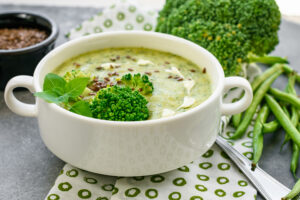Rice salads are a popular choice for many people who want to enjoy a light and refreshing meal. They are easy to prepare, versatile, and can be customized with different ingredients and dressings. But are they really that healthy or not?
The answer depends on several factors, such as the type of rice, the amount of rice, the other ingredients, and the dressing. Let’s take a look at some of these factors and how they affect the nutritional value of rice salads.
Type of rice: There are many types of rice, such as white, brown, black, red, and wild rice. Each type has different nutritional properties, such as calories, carbohydrates, fiber, protein, and vitamins. Generally, whole grain rice (such as brown, black, red, and wild rice) is healthier than refined rice (such as white rice) because it contains more fiber, antioxidants, and minerals. Fiber helps with digestion, lowers cholesterol and blood sugar levels, and keeps you feeling full longer. Antioxidants protect your cells from damage and inflammation. Minerals support various bodily functions and prevent deficiencies.
Amount of rice: The amount of rice you use in your salad also matters. Rice is a starchy food that provides energy and carbohydrates. However, too much rice can also add extra calories and carbs to your diet, which can lead to weight gain and blood sugar spikes if you are not careful. A reasonable portion size for rice is about half a cup cooked or one-fourth cup uncooked. This equals about 100-150 calories and 22-34 grams of carbs.
Other ingredients: The other ingredients you add to your rice salad can make it more or less healthy. For example, adding fresh or cooked vegetables can increase the fiber, vitamin, and mineral content of your salad. Adding lean protein sources such as chicken, fish, eggs or beans can boost the protein and iron content of your salad. Adding nuts, seeds or cheese can add healthy fats and calcium to your salad. However, adding too many of these ingredients can also increase the calories, fat, and sodium content of your salad. Therefore, it is important to balance the quantity and quality of the ingredients you use.
Dressing: The dressing you use for your rice salad can also affect its healthiness. Some dressings are high in fat, sugar, and salt, which can negate the benefits of the other ingredients. For example, mayonnaise-based dressings can add up to 200 calories and 20 grams of fat per serving. Other dressings such as ranch, Caesar, or Thousand Island can also be high in calories and fat. On the other hand, some dressings are low in fat and calories but high in flavor and nutrients. For example, vinegar-based dressings such as balsamic, apple cider, or red wine vinegar can add only 10-20 calories per serving but also provide antioxidants and acetic acid that can lower blood sugar levels. Other dressings such as lemon juice, olive oil, or yogurt can also be healthy choices if used in moderation.
Conclusion: Rice salads can be healthy or not depending on how you make them. To make a healthy rice salad, you should choose whole grain rice over refined rice, use a reasonable amount of rice per serving, add a variety of nutritious ingredients, and use a low-fat and low-calorie dressing. By following these tips, you can enjoy a delicious and healthy rice salad that satisfies your taste buds and body.









